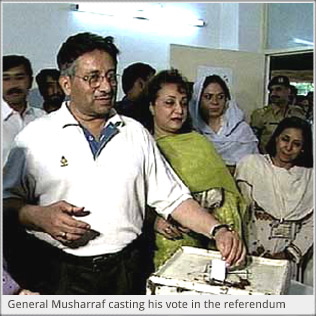After General Pervez Musharraf sacked the civilian Government headed by Prime Minister Mian Muhammad Nawaz Sharif on October 12, 1999, he had assumed the title of Chief Executive. It was claimed that the Army was forced to take this step to save the country from “turmoil and uncertainty”. The General later on also ousted President Rafiq Tarar and himself became the President of Pakistan. After becoming the President, he reiterated his stance of holding elections as prescheduled by his Government in October 2002. But before the general elections, a referendum was held on April 30, 2002 for General Pervez Musharraf to be elected as the President of Pakistan for another five years.
The basic reason for holding the referendum was that the General wanted to abide by democratic principles and establish legitimacy for his rule though in the Constitution there was no provision to become President through referendum. According to the General, he wanted to stay as President in order to continue the economic recovery, ensure social stability, to counter unnamed destabilizing influences, and to eventually return to “true democracy”. The Opposition parties opposed the referendum. A 15-party Alliance for the Restoration of Democracy was set up, including Pakistan’s two main political parties, the Pakistan Peoples Party and the Pakistan Muslim League. The alliance considered President Musharraf’s decision as unconstitutional and announced peaceful rallies to oppose it. They called for a boycott of the voting.
The referendum took place on April 30, 2002, with no competition and no option but to vote for General Musharraf. The referendum question put forward to the people was: “For the survival of the local government system, establishment of democracy, continuity of reforms, end to sectarianism and extremism, and to fulfill the vision of Quaid-i-Azam, would you like to elect President General Pervez Musharraf as President of Pakistan for five years?”
According to the Government there were 78 million eligible voters. Eighty seven thousand polling stations were set up, including booths set up at prisons, hospitals, petrol stations, workplaces, and markets. However, there were no voter lists or constituencies, and anyone who could prove his identity and age could vote at any polling station. According to the Government estimate, around 98 percent of the counted votes backed General Musharraf continuing in office and the turnout of the referendum was said to be around 70 percent.

The referendum result was quite a big question mark. Politicians and political analysts considered the referendum to be unconstitutional, as under the Constitution, the President could be chosen not via direct vote, but by the elected members of the National Assembly, Provincial Assemblies and the Senate. The Opposition claimed that not more than 5 percent of the electorate bothered to vote, implying that President Musharraf did not have popular support. Pakistan’s Human Rights Commission also gave reports of some flagrant abuses, with few instances of multiple voting, and pressure on state employees to cast their votes.
However, the referendum certified the continuation of President General Pervez Musharraf’s rule for another five years, with him claim to have the popular mandate to govern and to carry on with his economic and political reforms.
This article was last updated on Saturday, February 21, 2004






